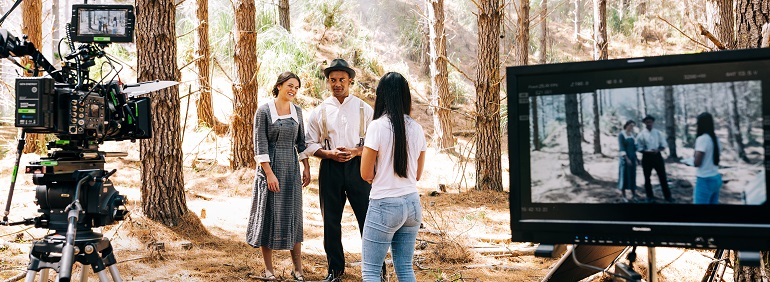Screen & creative
Tāmaki Makaurau is the hub of the country's film industry, and the region has earned an international reputation as a filming destination for screen production and post production.
On this page
The Screen and Creative sector in the region employ 55,218 people, with about 6.0% of those working in the city, representing almost 50% of the national screen and creative workforce. Screen and Creative is a highly productive and entrepreneurial sector with more than 5% contribution to Tāmaki Makaurau region's GDP, and workers are more likely to be self-employed. The sector is highly gig-orientated, with many self-employed workers who move from contract to contract. Amazon’s recent decision not to continue filming its Lord of the Rings production in the region highlights the precarious nature of the global industry.
Regional Skills Outlook(external link) — Infometrics
Tāmaki Makaurau also has a significant number of screen sector firms, with 1,935 businesses located here. These businesses generate almost 82% of the national revenue from the production of television programmes and commercials, amounting to $1.2 billion in production and post-production. 46% of the country's screen business is in Tāmaki Makaurau, contributing $2.4 billion and 74 per cent% of the national film industry revenue..
Economic trends in the New Zealand screen sector [PDF, 1.6 MB]
Toi Mai
The screen workforce is part of Toi Mai Workforce Development Council representing the Creative, Cultural, Technology and Recreation sectors, including Filmmaking, Journalism and Broadcasting, Music, Museums, Reserves and Conservation Parks, Hairdressing, Sports and Recreation. In 2021, Toi Mai Workforce Development Council industries had 61,484 filled jobs with a contribution of $6,874 million to GDP. There are 7.5% Māori employees (Infometrics 2022).
The gaming industry has done exceptionally well in Tāmaki Makaurau and earned $324 million in the Aotearoa -New Zealand games industry in March 2020, with almost 40 per cent% of Aotearoa New Zealand's gaming businesses located in the region. However, these businesses have been struggling with a talent shortage since the pandemic. The lack of talent has reached a crunch point over the last 2 years due to the impact of the pandemic on borders and immigration and workers moving offshore, especially to Australia, due to higher wages and lower cost of living . There is a long-standing demand for senior developers, art developers, game designers and advanced project managers recruited from overseas.
Auckland Film Studios(external link) — AucklandNZ.com(external link)
Video game sector growth is slowing due to a talent shortage(external link) — Stuff.co.nz
“Funding uncertainties make an average future – however, if work is funded in the next 12 months, my future is much more secure. I am at a tipping point personally.”
Screen sector worker
Screen and creative labour market and workforce insights
- The sector is forecast to grow both replacement and new jobs between now and 2027. There is a total of 23,465 job openings in this sector from 2022-2027, with 10,762 new jobs and 12,703 net replacement job openings.
Workforce planning challenges
- The industry has ongoing challenges with job security and continuity of roles based on project-based work and working conditions and practices, including long and unsociable working hours and lack of worker protections.
- Sourcing sustainable and secure employment is seen as a challenge to continue working in the sector, and opportunities to grow within and maintain employment are seen as a real challenge due to the casual nature of work and uncertainty.
- From industry views, it has been highlighted that the absence of a national approach, fragmentation within the industry, working in silos, and short-term thinking are holding the Screen sector back. There is a need to provide workforce support for freelance gig-based vocations and the challenges and skills needed to self-manage an entrepreneurial career in the Screen sector.
Regional Skills Outlook(external link) — Infometrics
Perceptions of careers in the screen sector - Final report [PDF 3.2MB](external link)
Screen and creative sector actions
- The RSLG supports a Māori workforce focus: There is an opportunity for the Screen and Creative sector to expand in Tāmaki Makaurau with Tāmaki 10,000 engaging Māori communities, whānau, hapū and iwi to become more proactively involved in communications and media, particularly as more opportunities for relationships between Māori and non-Māori productions arise in the future.
- The RSLG supports working with Screen Auckland to support workforce upskilling for the industry in West Auckland.
- The RSLG advocates secure and sustainable employment in the Screen and Creative sector given the casual nature of work within the sector, and to address workforce concerns around jobs.
- The RSLG will support and provide insights to the Toi Mai Workforce Development Council as they build regional sector insights and workforce and industry aspirations.
55,218 filled jobs in the screen and creative sector
23,465 new jobs in the next 5 years

Photo: Auckland Unlimited

